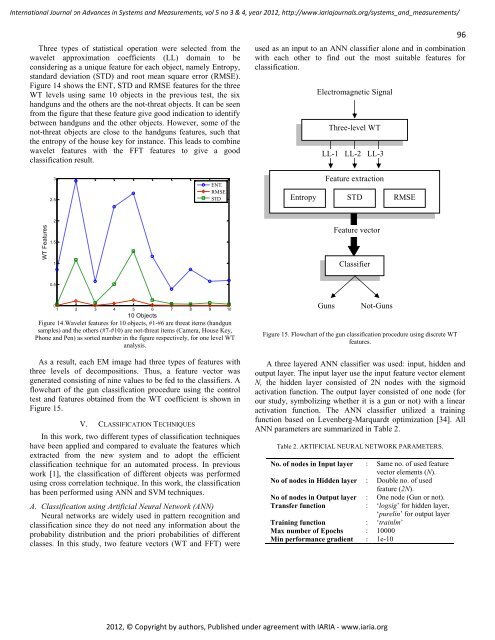c - IARIA Journals
c - IARIA Journals
c - IARIA Journals
Create successful ePaper yourself
Turn your PDF publications into a flip-book with our unique Google optimized e-Paper software.
International Journal on Advances in Systems and Measurements, vol 5 no 3 & 4, year 2012, http://www.iariajournals.org/systems_and_measurements/<br />
Three types of statistical operation were selected from the<br />
wavelet approximation coefficients (LL) domain to be<br />
considering as a unique feature for each object, namely Entropy,<br />
standard deviation (STD) and root mean square error (RMSE).<br />
Figure 14 shows the ENT, STD and RMSE features for the three<br />
WT levels using same 10 objects in the previous test, the six<br />
handguns and the others are the not-threat objects. It can be seen<br />
from the figure that these feature give good indication to identify<br />
between handguns and the other objects. However, some of the<br />
not-threat objects are close to the handguns features, such that<br />
the entropy of the house key for instance. This leads to combine<br />
wavelet features with the FFT features to give a good<br />
classification result.<br />
WT Features<br />
3<br />
2.5<br />
2<br />
1.5<br />
1<br />
0.5<br />
10 Objects<br />
Figure 14.Wavelet features for 10 objects, #1-#6 are threat items (handgun<br />
samples) and the others (#7-#10) are not-threat items (Camera, House Key,<br />
Phone and Pen) as sorted number in the figure respectively, for one level WT<br />
analysis.<br />
As a result, each EM image had three types of features with<br />
three levels of decompositions. Thus, a feature vector was<br />
generated consisting of nine values to be fed to the classifiers. A<br />
flowchart of the gun classification procedure using the control<br />
test and features obtained from the WT coefficient is shown in<br />
Figure 15.<br />
V. CLASSIFICATION TECHNIQUES<br />
ENT.<br />
RMSE<br />
STD<br />
0<br />
1 2 3 4 5 6 7 8 9 10<br />
In this work, two different types of classification techniques<br />
have been applied and compared to evaluate the features which<br />
extracted from the new system and to adopt the efficient<br />
classification technique for an automated process. In previous<br />
work [1], the classification of different objects was performed<br />
using cross correlation technique. In this work, the classification<br />
has been performed using ANN and SVM techniques.<br />
A. Classification using Artificial Neural Network (ANN)<br />
Neural networks are widely used in pattern recognition and<br />
classification since they do not need any information about the<br />
probability distribution and the priori probabilities of different<br />
classes. In this study, two feature vectors (WT and FFT) were<br />
2012, © Copyright by authors, Published under agreement with <strong>IARIA</strong> - www.iaria.org<br />
96<br />
used as an input to an ANN classifier alone and in combination<br />
with each other to find out the most suitable features for<br />
classification.<br />
Electromagnetic Signal<br />
Three-level WT<br />
LL-1 LL-2 LL-3<br />
Feature extraction<br />
Entropy STD RMSE<br />
Feature vector<br />
Classifier<br />
Guns Not-Guns<br />
Figure 15. Flowchart of the gun classification procedure using discrete WT<br />
features.<br />
A three layered ANN classifier was used: input, hidden and<br />
output layer. The input layer use the input feature vector element<br />
N, the hidden layer consisted of 2N nodes with the sigmoid<br />
activation function. The output layer consisted of one node (for<br />
our study, symbolizing whether it is a gun or not) with a linear<br />
activation function. The ANN classifier utilized a training<br />
function based on Levenberg-Marquardt optimization [34]. All<br />
ANN parameters are summarized in Table 2.<br />
Table 2. ARTIFICIAL NEURAL NETWORK PARAMETERS.<br />
No. of nodes in Input layer : Same no. of used feature<br />
vector elements (N).<br />
No of nodes in Hidden layer : Double no. of used<br />
feature (2N).<br />
No of nodes in Output layer : One node (Gun or not).<br />
Transfer function : ‘logsig’ for hidden layer,<br />
‘purelin’ for output layer<br />
Training function : ‘trainlm’<br />
Max number of Epochs : 10000<br />
Min performance gradient : 1e-10







